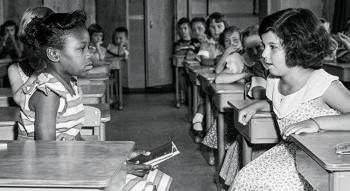
"In America, you can segregate the people, but the problem will travel. From slavery to equal rights, from state suppression of dissent to crime, drugs and unemployment, I can't think of a supposedly Black issue that hasn't wasted the original Black target group and then spread like measles to outlying white experience." - June Jordan
Misconceptions about School Segregation
- Though the landmark case Brown v. Board of Education declared racially "separate but equal" schools unconstitutional in 1954, school desegregation did not begin in earnest until Congress intervened a decade later.
- Opposition to racial segregation in public education was brought up as early as 1849. Kansas was the site of several of those cases spanning from 1881 to 1949.
- Integration of public schools has largely regressed across the country. Several factors including income inequality, housing disparity, and unfavorable redistricting of neighborhoods through gerrymandering have impeded the ability of Black families to move to better school districts.
- School integration in America was only truly enforced for less than two decades. Many large school districts across the nation are still heavily segregated.
- School integration works. During the height of school integration from the mid 1970s to mid 1980s, the achievement gap between black and white students were at their most narrow.
How to have a conversation about School Segregation
- Consider the racial composition of the room: The conversation may need to be tailored differently if there are few, many, or no people of color involved. Larger audiences with mostly white participants may need more information and examples as the topic will likely be far removed from their experience.
- Connect the past to the present: Racism in the United States has a long and abhorrent past. Where relevant, provide historical background to current incidents to give perspective.
- Talk about structural racism and white privilege: White privilege, the often unrecognized advantages, benefits, or rights conferred upon white people, is an important concept when talking about racism. The flip side of white privilege is structural racism which oppresses and marginalizes people of color through societal institutions like education, law enforcement, voting, employment and other systems.
- Leave on a message of hope and activism: As we talk about and unpack issues surrounding racial bias, it's important that we don't leave the audience with overwhelming feelings of hopelessness and despair. Many of these issues can be overcome through conversation, a shared understanding of the problem, and action.